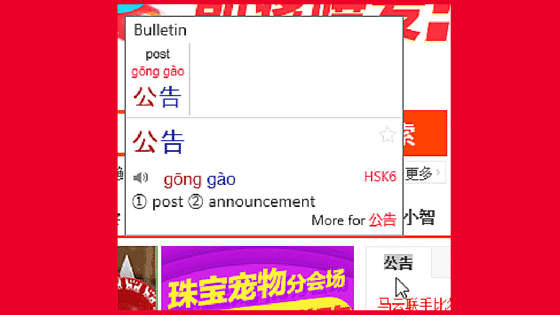It will only take [est_time] to read this post!
At Written Chinese, we always trying new methods of study that gets away from rote memorization and other traditional learning methods. You’ve heard us talk about using Chinese TV Shows to improve listening and using your mobile phone’s voice software to improve your tones, but now we’ve got a new tool that will allow you to learn Chinese or improve your Chinese character reading just by doing everyday stuff, like checking emails, searching the web or chatting online.
Now, you can say, “Hollie, I’m already doing that when I chat with Chinese friends, or post on Weibo or purchase something from Taobao”, and I’m likely to agree with you. However, the Written Chinese Reader is going to make your Chinese learning even more convenient.
Written Chinese Reader
The long and the short of it is, the Reader can translate Chinese characters into full sentences that actually make sense. All you need to do is hover or scan over the characters you want to learn and it will give you a translation.
There are several different versions, but if you want to try it out, you can check out the free download of the Written Chinese Reader.
Here are 8 tips for you to follow to get the most out of the great functions that the Written Chinese Reader has:
Tip 1: Learn HSK
If the word you looked up is part of the HSK qualifications, it will show the level in the top right-hand corner of the word. You can turn this function off if you wish, but personally, I think this is an extremely useful tool if you’re studying towards an exam. If you’re studying for a specific level, and you find a word, just click the ‘favorites’ star on the left-hand side and it will be added to your list of words to learn.
Tip 2: Change the tone markers
Just like in the WCC Dictionary and Written Chinese Online Dictionary, the Written Chinese Reader has colour coded tones. However, one great advantage of using the Reader, is that you can actually change the colour of the tones, you match your learning method. A while ago, one of our users told me that he personally uses blue for the first tone (instead of traditional red) because it reminded him of a calm sea.
Alternatively, you can turn off the coloured tones if you prefer, and only use a tone marker next to the character.
Similarly to the Written Chinese Online Dictionary, you can use numbers instead that add a number 1- 5 next to the pinyin.
Finally, if you really want to drive those tones home, you can switch all of the options on (or off), although that might get a little confusing.
Tip 3: Pin to your desktop
There’s a really cool feature that allows you to pin the translation to your desktop. If you want to learn those words, you can keep them there to check back on without going to your ‘favourites’ list. From the pinned translation, you can right click on the character or pinyin and do a multitude of tasks including copy, look up and search for a ‘real life’ example of the word on an external Chinese site.
Tip 4: Search ‘real life’ examples
Right click to search for a word in an online dictionary or media platform (Baidu images, music, video etc). This is a really interesting feature, that’s also a good time saver. When you use the Lookup or highlight tool, you can right click on any of the characters to do various different tasks, including search ‘real life’ examples of the word you searched for or scanned.
Say for example, I search for the word ‘holiday’ and then right click on the characters. Go down to ‘Search’ and then use one of the sites to look for the Chinese word.
Here are some great reasons to use this function:
Tip 5: Add Premium Dictionaries
If you’re a professional who needs to learn Chinese for your job, there are 3 additional specialised dictionaries that can be purchased. The dictionaries are for the following specialized subjects:
Tip 6: Translate into 89 different languages
You can actually change the language to auto-translate into your native language, not just English. This is a paid feature, but extremely convenient if English is not your first language.
Go to Settings then Auto Translate. Set your language and the auto translations should begin immediately. If you are using credits on the free Written Chinese Reader this function can easily be turned off and on.
Tip 7: Add your own words to the dictionary
You can easily customise the definitions and words that are shown in the dictionary. You can change definitions to be more simplified and even add brand new vocabulary to the dictionary. This is great if you want to add Chinese slang or even chengyu to the dictionary and learn them for fun.
Tip 8: Easily turn the functions off and on
If you’re not doing any Chinese learning, you can easily turn off the Chinese Reader so that it stops automatically translating your work. Just tap the Written Chinese logo in the left corner of the Lookup box to disable the features. To enable to features, just click again and the logo will turn red.
Try the Written Chinese Reader
The Written Chinese Reader 8 is currently available for Windows and is free. There are also premium versions which you can purchase to unlock additional content.









